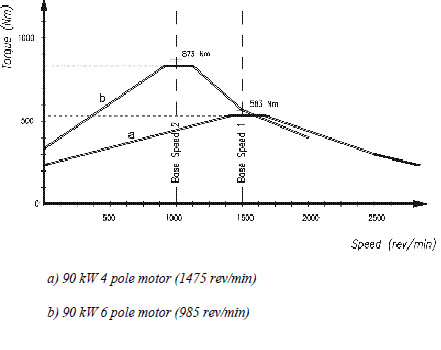- This topic has 1 reply, 1 voice, and was last updated 2 years, 11 months ago by .
-
Topic
-
What are the differences among variable speed,variable frequency and inverter drives? Can normal motors be used for above use?
What are the differences among variable speed,variable frequency and inverter drives? Can normal motors be used for above use?
Viewing 1 replies (of 1 total)
Viewing 1 replies (of 1 total)
- You must be logged in to reply to this topic.

 Manufacturers of electric motors and frequency converters have evolved various methods for quickly selecting the size of motors and frequency converters for a particular machine load. The same basic procedure is used by most applications engineers. These days, applications selections are usually done on the basis of PC based software. However, it is important for engineers to clearly understand the selection procedure. One of the best procedures uses a simple Nomogram based on the load limit curves to make the basic selection of motor size. This procedure is described below. The other factors are then checked to ensure that the optimum combination of motor and converter is selected. The following selection principles are recommended: 1. First, the type and size of motor should be selected. The number of poles (basic speed) should be chosen so that the motor runs as much as possible at a speed slightly above the base speed of 50 Hz. This is desirable because: – The thermal capacity of the motor improves when f ? 50 Hz because of more efficient cooling at higher speeds. – The converter commutation losses are at minimum when it is operating in the field weakening range above 50 Hz. – For a constant torque load, a larger speed range is obtained when the motor operates well in the field weakening range at the maximum speed. This means that the most efficient use is made of the torque/speed capability of the variable speed drive. This could mean cost savings in the form of a smaller motor and converter. – Although many manufacturers claim that their converters can produce output frequencies of up to 400 Hz, these high frequencies are of little practical use except for very special (and unusual) applications. The construction of standard cage motors and the reduction of the peak torque capability in the field weakening zone, restrict their use at frequencies above 100 Hz. The maximum speed at which a standard squirrel cage motor can be run should always be checked with the manufacturer, particularly for larger 2-pole (3000 rev/m) motors of more than 200 kW. The fan noise produced by the motor also increases substantially as the speed of the motor increases. – A comparison of the torque produced by a 4 pole and a 6 pole motor is shown in Figure below. This illustrates the higher torque capability of the 6 pole machine.
Manufacturers of electric motors and frequency converters have evolved various methods for quickly selecting the size of motors and frequency converters for a particular machine load. The same basic procedure is used by most applications engineers. These days, applications selections are usually done on the basis of PC based software. However, it is important for engineers to clearly understand the selection procedure. One of the best procedures uses a simple Nomogram based on the load limit curves to make the basic selection of motor size. This procedure is described below. The other factors are then checked to ensure that the optimum combination of motor and converter is selected. The following selection principles are recommended: 1. First, the type and size of motor should be selected. The number of poles (basic speed) should be chosen so that the motor runs as much as possible at a speed slightly above the base speed of 50 Hz. This is desirable because: – The thermal capacity of the motor improves when f ? 50 Hz because of more efficient cooling at higher speeds. – The converter commutation losses are at minimum when it is operating in the field weakening range above 50 Hz. – For a constant torque load, a larger speed range is obtained when the motor operates well in the field weakening range at the maximum speed. This means that the most efficient use is made of the torque/speed capability of the variable speed drive. This could mean cost savings in the form of a smaller motor and converter. – Although many manufacturers claim that their converters can produce output frequencies of up to 400 Hz, these high frequencies are of little practical use except for very special (and unusual) applications. The construction of standard cage motors and the reduction of the peak torque capability in the field weakening zone, restrict their use at frequencies above 100 Hz. The maximum speed at which a standard squirrel cage motor can be run should always be checked with the manufacturer, particularly for larger 2-pole (3000 rev/m) motors of more than 200 kW. The fan noise produced by the motor also increases substantially as the speed of the motor increases. – A comparison of the torque produced by a 4 pole and a 6 pole motor is shown in Figure below. This illustrates the higher torque capability of the 6 pole machine.  2. The selection of an oversized motor just to be
2. The selection of an oversized motor just to be